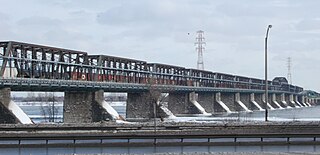
Sir Samuel Morton Peto, 1st Baronet was an English entrepreneur, civil engineer and railway developer, and, for more than 20 years, a Member of Parliament (MP). A partner in the firm of Grissell and Peto, he managed construction firms that built many major buildings and monuments in London, including the Reform Club, The Lyceum, Nelson's Column and the new Houses of Parliament; which made him a millionaire.

Sir Kazimierz Stanisław Gzowski,, was an engineer known for his work on a wide variety of Canadian railways as well as work on the Welland Canal. He also served as acting Lieutenant Governor of Ontario from 1896 to 1897.

The Victoria Bridge, previously known as Victoria Jubilee Bridge, is a bridge over the St. Lawrence River, linking Montreal, Quebec, to the south shore city of Saint-Lambert.

The London, Chatham and Dover Railway was a railway company in south-eastern England created on 1 August 1859, when the East Kent Railway was given parliamentary approval to change its name. Its lines ran through London and northern and eastern Kent to form a significant part of the Greater London commuter network. The company existed until 31 December 1922 when its assets were merged with those of other companies to form the Southern Railway as a result of the grouping determined by the Railways Act 1921. The railway was always in a difficult financial situation and went bankrupt in 1867, but was able to continue to operate. Many of the difficulties were caused by the severe competition and duplication of services with the South Eastern Railway (SER). However, in 1898 the LCDR agreed with the SER to share the operation of the two railways, work them as a single system and pool receipts: but it was not a full amalgamation. The SER and LCDR remained separate companies with separate shareholders until both becoming constituents of the Southern Railway on 1 January 1923.

The siege of Sevastopol lasted from October 1854 until September 1855, during the Crimean War. The allies landed at Eupatoria on 14 September 1854, intending to make a triumphal march to Sevastopol, the capital of the Crimea, with 50,000 men. Major battles along the way were Alma, Balaklava, Inkerman, Tchernaya, Redan, and, finally, Malakoff. During the siege, the allied navy undertook six bombardments of the capital, on 17 October 1854; and on 9 April, 6 June, 17 June, 17 August, and 5 September 1855.

Thomas Brassey was an English civil engineering contractor and manufacturer of building materials who was responsible for building much of the world's railways in the 19th century. By 1847, he had built about one-third of the railways in Britain, and by time of his death in 1870 he had built one in every twenty miles of railway in the world. This included three-quarters of the lines in France, major lines in many other European countries and in Canada, Australia, South America and India. He also built the structures associated with those railways, including docks, bridges, viaducts, stations, tunnels and drainage works.

The Victoria Bridge crosses the River Severn between Arley and Bewdley in Worcestershire, England. At the time of its construction, the 200-foot railway bridge was the longest single span cast iron bridge in Britain.

The Grand Crimean Central Railway was a military railway built in 1855 during the Crimean War by Great Britain. Its purpose was to supply ammunition and provisions to Allied soldiers engaged in the Siege of Sevastopol who were stationed on a plateau between Balaklava and Sevastopol. It also carried the world's first hospital train.

Edward Ladd Betts was an English civil engineering contractor who was mainly involved in the building of railways.
James Beatty was an Irish railway engineer.
Donald Campbell was a railway engineer in the 19th century.

The Queensland Railways A10 Neilson class locomotive was a class of 0-4-2 steam locomotives operated by the Queensland Railways.

The Irish Commemorative Stone is a monument in Pointe-Saint-Charles, island of Montreal, Quebec commemorating the deaths from "ship fever" (typhoid) of 6,000 mostly Irish immigrants to Canada during the immigration following the Great Irish Famine in 1847-48. It is a 30-tonne, 10-foot high boulder.

Ballard is a rural locality in the Lockyer Valley Region, Queensland, Australia. In the 2016 census, Ballard had a population of 151 people.

The Nepean River railway bridge is a heritage-listed railway bridge that carries the Main Southern railway line across Menangle Road and the Nepean River located at the outer south-western Sydney settlement of Menangle in the Wollondilly Shire local government area of New South Wales, Australia. It was designed by John Whitton as the Engineer-in-Chief, of the New South Wales Government Railways and NSW Department of Public Works. The railway bridge was built in 1863 by Messers Peto, Brassey and Betts. It is also known as Menangle rail bridge over Nepean River and Menangle Railway Bridge. The property was added to the New South Wales State Heritage Register on 2 April 1999.
Peto and Betts was a civil engineering partnership formed in 1848 between Morton Peto and Edward Ladd Betts that was mainly involved with the construction of railways in the UK and abroad.
Grissell and Peto was a civil engineering partnership between Thomas Grissell and his cousin Morton Peto that built many major buildings and monuments in London and became one of the major contractors in the building of the rapidly expanding railways of the time.

Main Range Railway is a heritage-listed railway from the end of Murphys Creek railway station, Murphys Creek to the Ruthven Street overbridge, Harlaxton, Queensland, Australia. It forms part of the Main Line railway and was built from 1865 to 1867 by railway builders Peto, Brassey and Betts. It was added to the Queensland Heritage Register on 5 February 2009.

Sadliers Crossing Railway Bridge is a heritage-listed railway bridge at over Bremer River between Tallon Street, Sadliers Crossing and Dixon Street, Wulkuraka, Queensland, Australia on the Main Line (this section is now the Ipswich and Rosewood railway line. It was added to the Queensland Heritage Register on 13 November 2008.
















